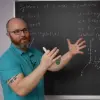

NARROW DISPLAY WARNING
You are most likely using a tablet or mobile device in portrait orientation. This website is best viewed using a typical computer screen with the browser window maximized.
Viewing this website in portrait orientation can cause problems with equations being longer than the screen width (you can scroll to the right), images being poorly sized, and the font size of maths text being much smaller than regular text. If your only option is a tablet or mobile device, your viewing experience will be better if you view this website in landscape orientation. You might need to refresh the page to fix any problems after rotating.
The most common differential equation mixing problem is a tank of water with salt water being poured in at the same rate water is flowing out of the tank. There are a few variations which are all typical homework exercises in an introductory differential equations course. A real world application is polluted water flowing into a large lake which also has an outlet, solving the ODE to determine how polluted the water will be over time.
A tank initially containing 500L of fresh water has salt water flowing into it at a rate of 10L per minute with a concentration of 0.3g of salt per 1L of water. The tank has a drain at the bottom also flowing at 10L per minute. Write an ODE for the g of salt $Q(t)$ in the tank at time $t$ where $t$ is in minutes. Assume the tank is thoroughly mixed so the salt in the tank is even distributed throughout the entire tank.
A tank initially containing 500L of fresh water has salt water flowing into it at a rate of 10L per minute with a concentration of 0.3g of salt per 1L of water. The tank has a drain at the bottom also flowing at 10L per minute. When will the concentration of salt in the tank be within 2% of the limiting value?
A tank initially containing 700L of fresh water has salt water flowing into it at a rate of 8L per minute with the concentration of salt varying over time given by $2 + \sin(t)$ g salt per 1L of water. The tank has a drain at the bottom also flowing at 8L per minute. Write an ODE for the g of salt $Q(t)$ in the tank at time $t$.
A tank initially containing 300L of fresh water has salt water flowing into it at a rate of 5L per minute with a concentration of 0.4g of salt per 1L of water. The tank has a drain at the bottom also flowing at 5L per minute. After 10 minutes, the salt water flowing into the tank is replaced with fresh water. Calculate how much salt is in the tank 5 minutes after fresh water started flowing into the tank.
A tank initially containing 250L of fresh water has salt water flowing into it at a rate of 3L per minute with a concentration of 0.25g of salt per 1L of water. The tank has a drain at the bottom flowing at 1L per minute, so the volume of water in the tank is increasing over time. Write an ODE for the g of salt $Q(t)$ in the tank at time $t$.